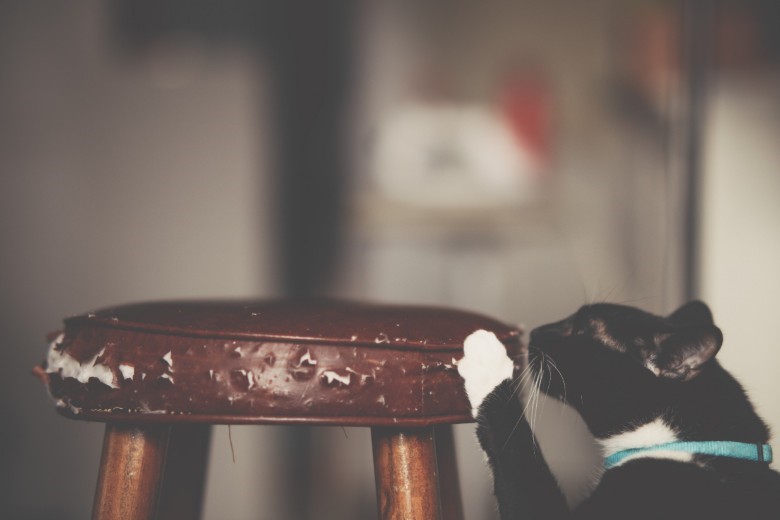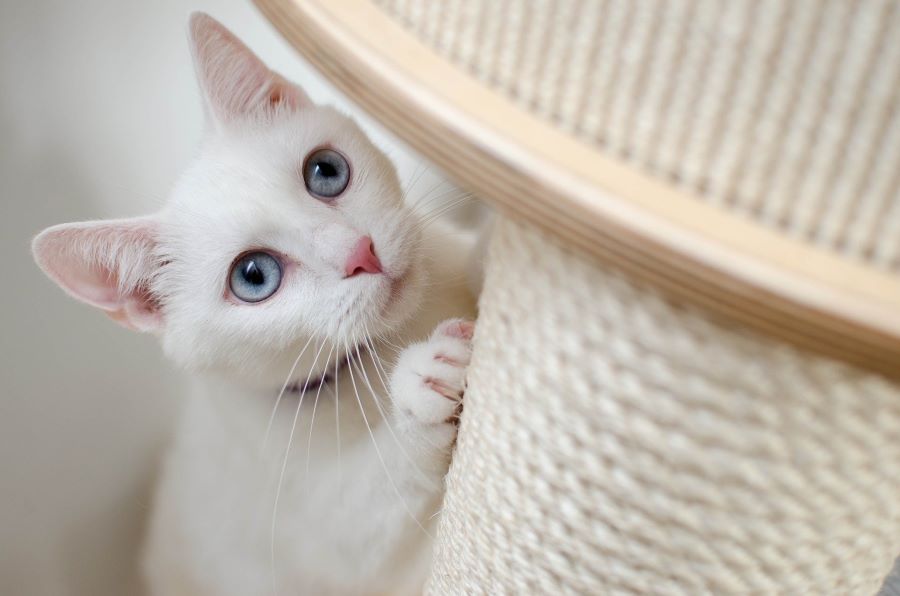Scratching is second nature to cats. Apart from the fact that they need it to keep their claws sharp and free of dead outer sheaths, it also serves as a much-needed exercise technique to stretch and strengthen their upper bodies. However, nobody likes to see their furniture redecorated with scratch marks, hence the need to know how to stop your cats from scratching furniture.
In this article, you will learn how to prevent your cats from defacing your furniture under the following subheadings:
- Why do cats scratch?
- Should declawing be an option?
- Ways to control your cat’s scratching
- How to trim your cat’s nails
Let’s dig in!
Why Do Cats Scratch?
Understanding why your cats scratch things is the first step to controlling the activity which forms a behavior after a while. Cats scratch for several reasons, including:
- Territorial marking – Your cat’s paws contain scent glands that release certain odors which your cat uses to mark that area as his/her territory. This method of communication is crucial to feline social structures.
- Claw health maintenance – Your kitty needs to periodically shed the outer husk of his/her nails to maintain healthy claws.
- Stretching – Cats need to stretch the muscles and tendons in their body from the neck and shoulders to the toes. They also need it to exercise their body.
- Feeling good – Cats feel good when they scratch. It’s like itching and it has a way of relieving stress while it also helps to prevent your cat from developing some undesirable behaviors.

Should Declawing Be An Option?
We have now seen why scratching is crucial and beneficial to cats.
However, should we consider declawing our cats as a way to permanently prevent them from scratching our furniture? The answer is a loud and clear NO. As I’ll briefly explain, all the declawing procedures are either harmful or painful to your cat.
A declawed cat may undergo one of three surgical procedures: tendonectomy, onychectomy, or laser surgery.
- Tendonectomy is the surgical removal of part of the flexor tendons. In this procedure, your kitty’s claws are left intact but your cat will not be able to extend the claws as they are no longer connected to the brain.
- Onychectomy, on the other hand, is the amputation of 1/3 of your kitty’s paws with the claws. This procedure is no doubt the most painful of the three. You can imagine the pain associated with this kind of procedure, fraught with several possible complications during and after surgery. It will also most likely change the way your cat balances, walks and interacts with her world.
- Laser surgery is quite similar to Onechectomy but in this case, a laser is used to seal off nerve endings that carry pain sensations to the brain. Laser surgery does not require pressure bandages, but you must monitor your kitty for bleeding nonetheless. As you would expect, laser surgery is more expensive than a standard Onychectomy, but is fast becoming a new method of declawing because of its safety, faster healing, and decreased postoperative discomfort.
Declawing is often considered inhumane, and is banned in several countries, and may soon become illegal in some cities in the US.
No cat lover would ever put their cat under severe suffering, just for the sake of not having their furniture scratched. Especially because there are many great ways to protect your furniture, while also protecting your cat.
If it becomes absolutely necessary to declaw in a situation where all other alternatives have proven to be ineffective, and the cat is at risk of euthanasia, please ask your vet for further information. He can discuss these procedures with you so that you have a better understanding of exactly how these procedures are performed, as well as the cost and what to expect. For more information, you can read ASPCA’s position on the declawing of cats.
Ways to control your cat’s scratching
There are alternative ways to keep your cat from scratching away at your furniture and we will look at some good ones here.
The “Yes” Way (Cat Furniture & Catnip)
The “Yes” way simply refers to the appropriate places where you can give your cat a go-ahead to let out those scratching instincts and they are critical for long-term behavioral success. To make this work, we recommend that you make several scratching posts available, depending on the number of areas your cat already likes to scratch on. If your furry friend often goes for both arms of the couch, for instance, you will definitely want to place your posts on the two sides at the start.
When you get a new piece of cat furniture, such as a cat tree with scratching posts, dangle your cat’s favorite toy from the top, or rub it with catnip to create a game that encourages your cat to mimic the motion of scratching. Lavish praises on your kitty whenever he/she scratches the cat furniture to help create a positive association with the act of scratching the cat furniture.
Ensure that the cat furniture has a solid base that can easily support the weight of your cat. If the cat furniture wobbles while your cat is trying to climb, that will erode confidence and lead your cat back to your nice furniture.

The “No” Way
Getting your cat to stop scratching her favorite spot can be challenging but there are ways to do it. The trick is to remove the pleasurable component and replace the action with something not quite nice.
The following measures are useful:
- Cover up the spot with tin foil. This works better using a double-sided tape like Sticky Paws. This tape is quite nice as it comes in different versions and sizes designed specifically for furniture or plants
- Set up a vinyl carpet runner with the spike side up in front of the spot where they love to scratch
- Use a non-sticky, clear plastic protector for your cat’s nails like Purrfect Paw
Note that aversive methods will only work when the cat is provided with an alternate surface that is equally or more desirable.
You must be patient, knowing that incorporating this new behavior into his routine may take a few months without having any “slips”.
Regularly trim your cat’s nails
You should normally clip your cat’s nails every 2-3 weeks. You will find the following tips useful as well:
- Start at a young age: It is better to start trimming when your cat is still a kitten. You can easily put him/her on the right path than to retrain an adult cat, but even older cats can learn to enjoy having their feet handled and to accept nail trimming.
- Sneak up during a nap: You can sneak up on your cat while napping and clip a few nails with no stress whatsoever. Be quiet and gentle. If your kitty wakes up and pulls away, that’s okay. You’ll most likely get another chance soon.
- Take it slow: Your tomcat’s paws are one of his most sensitive parts. He will often pull away from you and make the task more stressful for both of you. If your cat is sensitive, try warming him up to the concept during petting sessions. Touch one of his paws when he is most relaxed. Then, push gently on his pads, extending a claw, praising him the whole time. Know when he’s had enough, and respect his boundaries.
- Cut the tips only: The most critical part to cut off is the sharp end of the nail that can puncture furniture and give leverage to cause damage. In most cats, when the nails are extended you can easily see the clear part and the pink part. All you need to clip is the end of the clear part (this article goes in great detail on how to trim your cat’s nails)
- Use sharp trimmers: Using dull trimmers will crush and splinter the nail. You can easily replace the blade of guillotine (Resco) type trimmers.
In conclusion, correct your kitty gently and offer praises when he/she is doing the right thing. If you put all you have learned here into action, you will have a well-behaved cat on your hands in no time.
Resources
- Declawing cats: Banning declaw surgeries, https://www.cathealth.com/scratching/declawing/2268-banning-declaw-surgery
- ASPCA’s position statement on the declawing of cats, https://www.aspca.org/about-us/aspca-policy-and-position-statements/position-statement-declawing-cats
